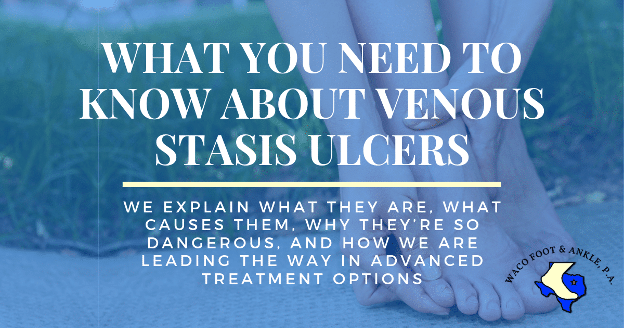What You Need to Know About Venous Stasis Ulcers
Ulcers on the feet and legs are one of the most serious and expensive acute health problems facing Americans today. They are responsible for by far most non-traumatic lower limb amputations, with nearly 100,000 cases in America each year.
You probably already know that diabetic foot ulcers are a major part of the problem. But you might not know as much about venous stasis ulcers—which are also relatively common and can be just as dangerous.
In this blog, you’ll learn a little bit more about what venous ulcers are, why they’re so dangerous, and why Waco Foot & Ankle is leading the way when it comes to treating and healing these dangerous wounds and preserving your way of life.
Venous Insufficiency—When Veins Go Bad
Let’s start from the beginning.
Your circulatory system is the primary means by which your body delivers oxygen and nutrients to all your cells and organs and carries away any waste products they produce. Arteries are the blood vessels that carry oxygenated blood from your heart to your body, while veins take blood back to the heart.
That’s not the only difference between them, however. While arteries tend to be strong, muscular, and flexible, veins are smaller and operate at relatively low blood pressure. They therefore rely on adjacent skeletal muscles (such as your calves) to move blood along, through a series of one-way valves that keeps it flowing in the correct direction.
Unfortunately, if the valves and/or vessel walls in the veins aren’t functioning correctly or effectively, it gets harder and harder for the blood in your feet and legs to work against gravity and get all the way back to the heart. Instead, some of your blood starts pooling or even flowing backward and collecting in these veins.
The cause of venous insufficiency is not always clear, but several conditions are known to either cause or increase your risk of developing it. These include:
- A blood clot in a deep vein (deep vein thrombosis, or DVT)
- Diabetes
- Obesity
- Pregnancy
- Smoking
- Congestive heart failure
- High blood pressure
- Peripheral vascular disease
- Inflammation in the vein (phlebitis)
- History of injury, surgery, or blood clots in the legs
- Family history
One thing that might shock you is that chronic venous insufficiency (CVI) is extremely common. In fact, it’s estimated that up to 40 percent of Americans have some form of the condition.
Although most of these cases may still be in the earlier stages, CVI develops slowly over time—and if you don’t take steps to prevent and treat it now, it can easily lead to more severe complications down the road.

From Insufficiency to Ulcers
As the venous insufficiency gets worse, you may start to observe some of the following symptoms:
- Swelling in your legs and ankles, particularly after you’ve been standing for a while.
- Aches, pain, tightness, and fatigue in the legs. They may even feel itchy.
- Development of varicose veins (twisted, enlarged, bulging veins in the leg which may be obvious and appear purple or dark blue).
- Skin that appears darkened or even leathery.
As the condition progresses further, the pressure of the pooling blood increases, stretching out the vein walls to the point where blood begins to leak out into the subcutaneous tissues under the skin.
Eventually, this leads to the development of venous stasis ulcers. They typically present on the lower leg or ankle and are relatively shallow but very large, with irregular borders. If infected, the wound may start to ooze.
You might be surprised to learn that venous stasis ulcers are not always particularly painful, though some are. But regardless of whether you’re experiencing discomfort, they are extremely dangerous and costly. Venous ulcers generally do not heal on their own but become stubbornly chronic and require medical intervention to heal. And left untreated, an infected wound can lead to gangrene, and ultimately require an amputation to keep the damage from spreading.
Leading the Way in Treating Venous Stasis Ulcers
Fortunately, there is some good news. Venous stasis ulcers—even very large ones—can almost always be treated non-surgically.
Even better, Waco Foot & Ankle is leading the way in helping Texans recover quickly and fully. We’re widely recognized throughout the heart of Texas for our advanced treatment options, available on site. This includes the use of amniotic membrane allografts as a wound covering, placed in direct contact with the ulcer and held in place with a secondary dressing.
Why is that so significant? Amniotic membranes are prepared from safely donated amniotic tissue, which means it’s packed with growth factors, cytokines, extracellular matrix proteins, and other key nutrients that are essential for wound healing.
Furthermore, the amniotic membrane we use contains living, viable cells and is preserved without dehydration, which means you get the highest possible concentration of these regenerative proteins.
As a result, using this product as a graft creates a sort of “natural scaffold,” upon which your own natural cells can regenerate and rebuild. Instead of scar tissue, the body creates new, healthy tissue. Your wound heals faster, with a better result—because the allograft gives it both the tools and the framework needed to repair itself efficiently.
If you detect the early warning signs of chronic venous insufficiency—or even develop a venous stasis ulcer—do not wait any longer to seek treatment. Early detection of insufficiency can prevent ulceration, while prompt treatment of the ulcer can help you keep your leg and return to full health and activity.
To schedule an appointment with us at our office in Woodway, please call (254) 776-6995 today. You can also request an appointment using our online contact form.
